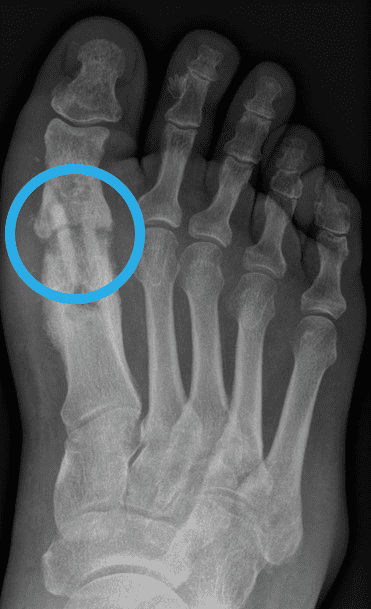A life with pseudarthrosis, an idea that is an absolute nightmare for many people. Do you really have to live with pseudarthrosis, or are there ways to cure pseudarthrosis? In this article about pseudarthrosis – bones that do not heal – by Dr. Klaus Pastl from Linz, specialist in orthopedics, foot surgery and hand surgery, you will learn all about the initial symptoms, causes and what treatment options are available to you and your surgeon to cure your pseudarthrosis. He explains what treatment options are available and what materials can be used in surgeries for pseudarthrosis. For example, allografts (human bone from tissue banks), as well as the use of screws made from human bone, such as the Shark Screw® have proven successful in the past for the surgical treatment of pseudarthrosis. However, conservative methods such as shock wave therapy may also be considered for non-healing bones or non-healing fractures.
Reading time: 4 min
Author of the article: Dr. Klaus Pastl
Foot surgeon and pseudarthrosis specialist in Linz
The author is a renowned specialist in Austria for foot surgery.
Definition: What is pseudarthrosis?
What is pseudarthrosis? If the bone has not healed 6 months after a fracture, it is defined as pseudarthrosis. Screws made from human bone are usually used for healing during surgery. The word pseudarthrosis comes from the Greek, where “pseudos” means false and “arthros” means joint. Pseudarthrosis is also known under the names pseudo joint or pseudo joint. Pseudarthrosis always occurs after a bone fracture or bone surgery, when the bone does not heal properly, the bone pieces do not grow together. As long as the bone is not completely healed, it cannot be loaded properly. “Trigger of a non-healing fracture is usually too early loading, but inflammation and infection can also limit the bone healing process. The bone does not grow together after a fracture, and as a result, pseudarthrosis develops.” According to the Expert from Linz, Dr. Klaus Pastl. Pseudarthrosis can occur on any Bone that does not healwhether it is a non-healing metatarsal surgery, a failed metatarsal implantation, or a Hallux rigidus surgery or a non-healing operation after a Scaphoid fracture acts. If pseudarthrosis occurs, it must be treated.
Hypertrophic, atrophic and other types of pseudarthrosis
Pseudarthrosis can be divided into 3 categories:
- Hypertrophic/atrophic pseudarthrosis: In hypertrophic pseudarthrosis, there is an increase in bone and cartilage tissue in the fracture gap; in atrophic pseudarthrosis, there is a decrease.
- Vital / Avital Pseudarthrosis: In vital pseudarthrosis, there is instability of the fracture, but formation of blood vessels (vascularization) is present. In avital pseudarthrosis, there is instability of the fracture combined with poor perfusion.
- Infectious pseudarthrosis: We speak of infectious pseudarthrosis when, in the absence of consolidation of the bone fragments, there is also a bacterial infection.
Pseudarthrosis can occur after both conservative (without surgery) and surgical treatments. Pseudarthrosis is not uncommon. According to studies, pseudarthrosis occurs in 3-10% of all patients after a bone fracture.1 It can occur at any age, and in both women and men. The higher the age of the patient at which pseudarthrosis occurs, the worse the bone fragments grow back together.
“Screws made from human bone have proven successful in pseudarthrosis surgery.” Dr. Klaus Pastl – Pseudarthrosis specialist in Austria.
Symptoms of pseudarthrosis
A clear sign of pseudarthrosis is when the bone fracture ends have not grown together stably within 4 – 6 months. Other typical symptoms of pseudarthrosis include redness, pain, and swelling over the unhealed bone area. “Since the stability of the bone is severely impaired by the pseudarthrosis, malpositions, movement restrictions, joint problems but also muscle atrophy often occur in the affected region,” explains Dr. Klaus Pastl, orthopedist from Linz. Most patients initially experience pain only during movement and exertion, but as the pseudarthrosis progresses, pain and symptoms also occur at rest. If pseudarthrosis occurs after implantation of metal screws or metal plates, reacting too late is particularly dangerous. If the bone does not heal in time, the entire weight rests on the metal plates and metal screws. These can fracture from the stress. “Broken metal parts in the body can be extremely painful for patients. These operations are also extremely unpleasant and difficult for the surgeon. “Operations are tedious and complex. Often, much bone must be destroyed and the surrounding soft tissues injured in order to retrieve the fractured metal pieces from the patient’s bone. Sometimes not all metal parts can be removed and must then remain in the bone. It’s frustrating, for patients and surgeons.”
Treatment of pseudarthrosis can be a lengthy process and can often take months. In most cases, only surgery can be considered for the successful treatment of pseudarthrosis. Patients who are fitted with screws made from human bone have a good chance of recovery.
You yourself suffer from pseudarthrosis and would like to know from a specialist whether it can be cured? We will be happy to recommend a specialist in your area. Confidential and free of charge.
Pseudarthrosis chances of cure
Pseudarthrosis is not uncommon after an accident or surgery. But if you have pseudarthrosis, what are the chances of recovery? “You have a good chance of recovery as a patient, with conservative therapies but also with surgical therapies. With conservative therapies, such as shock wave therapy, the chances of healing are between 50% – 85%. If this does not result in a cure, surgery is the treatment of choice. Screws made of bone have proven their worth here. Depending on the area of application, the chances of recovery are significantly higher here,” says pseudarthrosis specialist Dr. Klaus Pastl from Austria.
Pseudarthrosis Therapy & Treatment
The most suitable treatment option or therapy depends on the particular form of pseudarthrosis. Basically, however, a distinction is made between conservative therapy of pseudarthrosis and surgery of pseudarthrosis.
Conservative pseudarthrosis therapy
Conservative therapy is considered when patients suffer only minor pain and a cure seems possible without surgery. In addition, the pseudarthrosis should be recent. One possibility to treat pseudarthrosis conservatively is shock wave therapy.2
The pseudarthrosis surgery
Pseudarthrosis surgery is absolutely necessary when conservative therapies do not produce the desired results and pain persists. Possible pseudarthrosis surgeries are listed below:
- Insertion of donor bone (allograft) into the fracture gap:
- These are allografts and screws made from human bone such as the Shark Screw®.
- Bone Connecting, Osteosynthesis
- The osteosynthesis material used is usually screws made from human bone In the case of pseudarthrosis of large long bones, these can be used to supplement existing plate systems.
- Removal of the dead as well as infected tissue
- In some of the pseudarthrosis surgeries performed, the pseudarthrosis gap must be opened and the dead material removed so that new bone can grow and form. Subsequently, the resulting bone gap is filled with screws made from human bone and other allografts.
Are you looking for a pseudarthrosis specialist near you? We will be happy to recommend a specialist, free of charge and without obligation, who can provide you with information about possible treatments for your pseudarthrosis.
Can the Shark Screw® help to cure pseudarthrosis?
“I myself use Shark Screw® very successfully in the surgical treatment of my patients with pseudarthrosis! So yes, with Shark Screw® you have a good chance of curing pseudarthrosis,” says pseudarthrosis specialist Dr. Klaus Pastl from Austria. But why is Shark Screw® particularly suitable for pseudarthrosis? After insertion into the bone, Shark Screw® is colonized by the body’s own cells, grows through and is integrated into the natural bone remodeling process. The reason for this are the so-called Havers channels, which are located inside the Shark Screw®. “Shark Screw® serves as a guide substance and bridge for the body’s own cells in pseudarthrosis. The body’s own vessels and bone cells can settle and spread in these channels.3This process creates new bone structures, the formation of which is essential for healing pseudarthroses.
Are you suffering from pseudarthrosis and want to know if a Shark Screw® surgeon can help you get rid of it? We are happy to help you find a pseudarthrosis specialist near you free of charge.
What are the causes of pseudarthrosis?
Basically, pseudarthrosis is differentiated between mechanical and morbid causes. The mechanical cause includes, for example, an insufficiently stable bone joint after a bone fracture. Pseudarthrosis can also develop if the fracture was mobilized and/or loaded again too early and was thus immobilized for too short a time.
The morbid causes include, for example, nicotine abuse, infections, vascular diseases or metabolic diseases such as diabetes.
Other causes of pseudarthrosis may include:
- Too early/excessive loading of the fracture
- Insufficient stabilization (cooking parts shift against each other)
- Open fractures (infectious pseudarthrosis)
- Soft tissues (can get into the bone gap)
- Smoking (reduction of blood flow)
- Old age (healing process of the bones becomes worse with increasing age)
- Overweight (higher inflammatory activity)
- diabetes (reduction of blood flow and bone healing)
- Medication (e.g. cortisone)
- Radiation exposure
- Thyroid disease
Where can pseudarthrosis occur?
The long tubular bones are particularly susceptible to pseudarthrosis and include the femur, tibia, humerus, ulna and radius. Pseudarthrosis of the foot or hand is also not uncommon. Thus, they may occur after surgery for hallux valgus, hallux rigidus or other operations on the foot. Other areas where pseudarthrosis can often occur after surgery are:
- Scaphoid (general wrist) – read more about scaphoid fracture or scaphoid pseudarthrosis in the scaphoid article by scaphoid pseudarthrosis specialist Dr. Simon Sailer from Austria.
- Spine
- Shoulder or collarbone
- Hip
- Fibula
- Metatarsus / Metatarsal
- Ankle joint
- Inner/outer ankle
FAQs
How is pseudarthrosis diagnosed?
The diagnosis of pseudarthrosis is made via X-rays. In the case of unclear X-ray findings, a computed tomography (CT) or magnetic resonance imaging (MRI) may also be useful.
What is the pain associated with pseudarthrosis?
Pain occurs mainly in the area of the affected bones. Furthermore, instability as well as limitations of mobility occur.
What are the consequences of pseudarthrosis?
Zu den Folgen von Pseudarthrose zählen dauerhafte Funktionseinschränkungen sowie anhaltende Schmerzen. If there are limitations in everyday life, surgery should be considered.
1 Everding et. al, Extrakorporale fokussierte Stoßwellentherapie zur Behandlung von Pseudarthrosen Neue Erfahrungen mit einer alten Technologie, Der Unfallchirurg | Ausgabe 11/2017
2 Großner, T., Schmidmaier, G. Konservative Therapieoptionen der Pseudarthrosen. Unfallchirurg 123, 705–710 (2020). https://doi.org/10.1007/s00113-020-00851-1
3 Brcic I, Pastl K, Plank H, Igrec J, Schanda JE, Pastl E, Werner M. Incorporation of an Allogenic Cortical Bone Graft Following Arthrodesis of the First Metatarsophalangeal Joint in a Patient with Hallux Rigidus. Life (Basel). 2021 May 24;11(6):473. doi: 10.3390/life11060473. PMID: 34073841; PMCID: PMC8225087.





